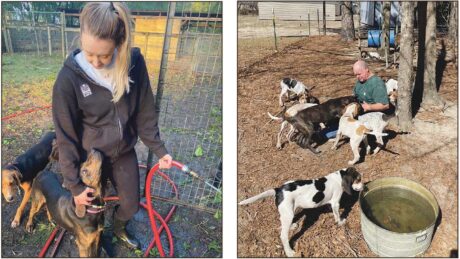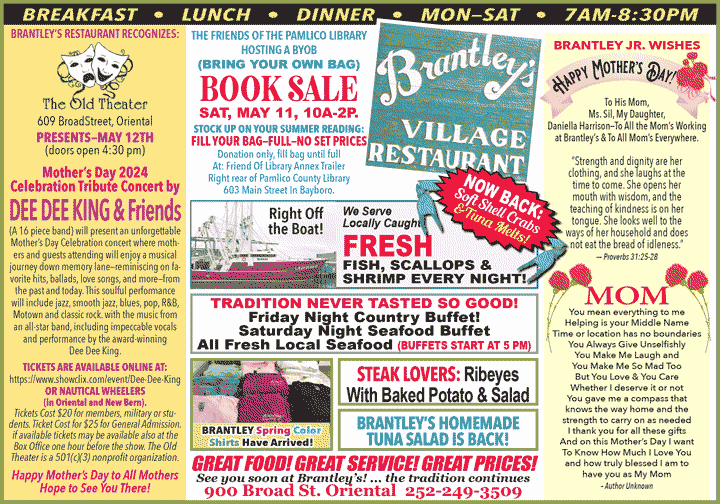Here We Present 12 Reasons for Continuing Tradition

By Reed Sheffield
NORTH CAROLINA – Mr. Sheffield serves on the board of directors for both the North Carolina Bear Hunters Association and the Eastern Carolina Houndsmen Alliance. This article responds to a commentary by Bill Lea in the Feb. 1 County Compass where Lea argues against using dogs to assist with bear hunting.
Hunting bears with hounds in the state of North Carolina is a time-honored tradition that exudes the spirits of community, fair chase, and conservation. In today’s world, the practice is rooted in, and governed by, scientific and biological data. Contrary to the beliefs of some, the assumptions of rampant barbarism and wanton waste being endemic to the practice at the hands of bear hunters and at the behest of the North Carolina Wildlife Resources Commission (NCWRC) are unfounded.
1. Annual bear harvest totals are reflective of guidelines that are founded in science and reflective of a healthy bear population. It is true that harvest totals have gone up annually, but this is in correlation with the exponential growth of the state’s black bear population, as shown in the attached graph.
The state of North Carolina has over 20,000 bears. This current population level is 12.4 times that of 1980, while the harvest rate has increased at a proportionally lower rate of 10.5. This is wonderful news for bears. The NCWRC, which serves as the stewards of the state’s wildlife, would only allow for sustainable regulations and harvest methods, and the numbers show that bear hunting with hounds is just that – sustainable. The robust and healthy bear population is indicative of, and due to, conservation efforts by hunters. This includes their active participation in bear data surveys, submission of biological data to wildlife officials, and the establishment of bear sanctuaries, among many efforts. The NCWRC bases their season dates, harvest allotment, and other regulations in large part based on hunter supplied data. Bear hunters themselves were instrumental in the founding and maintenance of bear sanctuaries in the state, which at present sits at over 490,000 acres of official black bear sanctuaries and 1,390,000 areas of de facto sanctuaries. The fair chase practices of hound hunters have contributed to a growth in the black bear population – quite factually the opposite from the assumptions of some.
2. Bear hunting with hounds is a method of fair chase hunting that is driven by a code of ethics that respects all wildlife, not least of which the bear themselves. No bear hunter with hounds would intentionally wound a bear to subject them and the dogs to undue violence. This is an absurd concept and would result only in injured dogs and hunters. Hunters stress over and strive for the use of one shot/ethical shot placement practices to ensure humane harvest and respect for the bear, as well as the safety of the dogs.
3. The hounds used by bear hunters are renowned and revered for not only their incredible athleticism and endurance, but also their incredibly friendly and loving nature. Many in fact make great house dogs. Accusations and characterizations of them as viscous attack animals are unfounded and easily dispelled myths. Readers are encouraged to refer to attached pictures to see just a small sample of the contrary. Examples of their loving nature are easily evidenced. Accounts of harm from these dogs to others such as Sadie Anderson’s case are an anomaly and confounded by possible attacks on the hounds themselves from other aggressive dogs.
4. Hunting bear with dogs is the most controlled form of fair chase and selective harvest option. Hunters can easily view bear for their sex, age, and size, and choose to leave the bear alone – and they so often do, or else populations wouldn’t continue to climb, even with the increase in the amount of both bear hunters themselves and bear harvest numbers.
5. Antiquated misconceptions of practices such as the so called “bear baying” (as described by Bill Lea) are misconstrued, unfounded myths that are simply not practiced by anyone in today’s time. In addition to these practices being highly illegal forms of animal cruelty, they simply do not happen. Bears can also be disturbed and harassed by seemingly harmless methods of bear/human interaction – such as excessive and invasive photography methods that may disturb the dens of young bears.
6. Harvest dates and season lengths are based solely on sound science, biological data, population levels. Any proposed changes in season lengths are reflective of a single sustainable goal – a healthy bear population. Currently, the number of tags available for hunters to use remains the same at one per person – and the only proposals the NCWRC are considering regarding increased season lengths is an increase in allowed dates only.
7. NCWRC’s objective is to have an “annual sustained” harvest – i.e. a harvest reflective of a sustainable population, and a harvest target that is sustainable and maintains healthy population levels. The key word is sustainable – both bear hunters and the NCWRC want to continue to see a healthy, and large black bear population in the state in order to continue the mutually beneficial relationship between hunters, residents, and black bears.
8. The use of dogs for bear hunting is allowed just as with many other game animals. There is no difference in practice, and it is a fair chase in all forms. Its allowance and continuance for the purpose of bear hunting is only because it is sustainable in nature, and in no way has had an adverse effect on the state’s black bear population – the data supports it.
9. The NCWRC does (contrary to the beliefs and misconceptions of some) in fact stress education regarding bears. The NCWRC is constantly showcasing and providing educational resources and events and is undoubtedly at the forefront of cutting-edge biological research. The NCWRC’s bear biology wing is widely regarded as the best in the entire country, and its trailblazing methodologies are continually being adapted by other states because of the incredible success story of the black bear in North Carolina. The NCWRC is a big proponent of “BearWise” behavior – tips to maintaining a healthy relationship between bears and humans. The NCWRC (and bear hunters themselves for that matter) are in no way wanting “elimination” for bears, and both parties are in fact incredible advocates for a strong, large, healthy, and robust population as well as coexistence.
10. The misconception of bear dogs being subjected to widespread animal cruelty, starvation, and lack of love is a false notion. Bear hounds are treated well and loved as family members. Hunters spend enormous amounts of money on the healthcare and wellbeing of their hounds. From vaccinations, preventative medications, top of the line dog food, and much more, – the health, care, and attention to the dogs is paramount. The misbelief that hounds are starved under the misconception that “skinny dogs run faster” is a fallacy. A malnourished dog is like an unconditioned athlete – they would not be able to perform. NC law requires humane treatment of dogs – bear hounds are no different.
11. Every bear is indeed unique, and they are as such meant to be respected. That fact is stressed explicitly in the bear hunting with hounds’ community. Bear hunters with hounds stress the least amount of suffering for the animal at harvest – one ethical shot. In addition, countless bears are left alone and unharmed in their natural, wild habitat by bear hunters with hounds as they are the greatest proponents of a selective harvest in order to ensure the continued tradition of hunting with hounds and the continued health of the bear population.
12. Bear hunting with hounds in North Carolina is a tradition dating to the colonial days and the nation’s founding. The North Carolina state dog (recognized as such by general statute), the Plott Hound, was developed in the state in the 1700s for the purpose of bear hunting. For over 300 years the tradition has brought together families, communities, and contributed to the successful growth of the black bear population in the state. The contributions of bear hunters with hounds helps the economy due to the money used to take care of their hounds, the purchase of licenses, gear, hotel rooms, seasonal rental properties, restaurants, and much more. Contrary to accusations of waste, bear meat from North Carolina provided 600,000 plates of food last year. Through bear hunting with hounds, communities are brought together as fundraisers are put on, Outdoor Dreams (an organization that grants wishes of children with terminal illnesses) are granted, Wounded Warrior hunts are put on at the request of our nation’s heroes and veterans, and much more. This tradition’s positive biological, socioeconomic, and fair chase aspects cannot be understated, or questioned.

















































